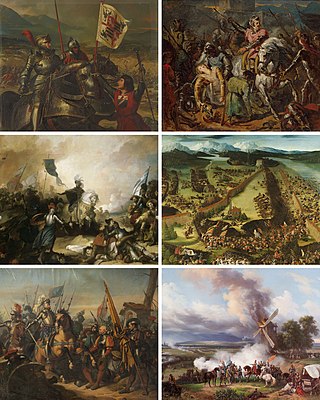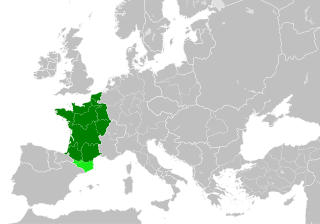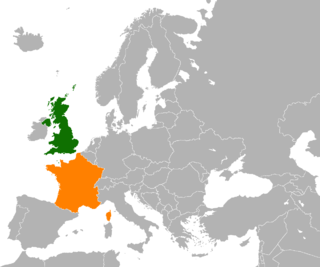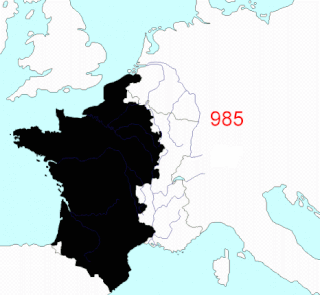Bibliography and external links
- Kohn, George C (2006). Dictionary of Wars. Infobase Publishing. ISBN 9781438129167.
- Lee, Roger. "Anglo-French Wars". The History Guy. Retrieved 1 January 2020.
The Anglo-French Wars were a series of conflicts between the territories of the Kingdom of England, its sequel United Kingdom and the Kingdom of France succeeded by a republic. Their conflicts spanned throughout the Middle Ages to the modern age. Those include the following.
Events that nearly brought the two countries to war:
The Capetian dynasty, also known as the "House of France", is a dynasty of European origin, and a branch of the Robertians. It is among the largest and oldest royal houses in Europe and the world, and consists of Hugh Capet, the founder of the dynasty, and his male-line descendants, who ruled in France without interruption from 987 to 1792, and again from 1814 to 1848. The senior line ruled in France as the House of Capet from the election of Hugh Capet in 987 until the death of Charles IV in 1328. That line was succeeded by cadet branches, the Houses of Valois and then Bourbon, which ruled without interruption until the French Revolution abolished the monarchy in 1792. The Bourbons were restored in 1814 in the aftermath of Napoleon's defeat, but had to vacate the throne again in 1830 in favor of the last Capetian monarch of France, Louis Philippe I, who belonged to the House of Orléans. Cadet branches of the Capetian House of Bourbon are still reigning over Spain and Luxembourg.

The Capetian house of Valois was a cadet branch of the Capetian dynasty. They succeeded the House of Capet to the French throne, and were the royal house of France from 1328 to 1589. Junior members of the family founded cadet branches in Orléans, Anjou, Burgundy, and Alençon.

The Italian Wars were a series of conflicts fought between 1494 and 1559, mostly in the Italian Peninsula, but later expanding into Flanders, the Rhineland and Mediterranean Sea. The primary belligerents were the Valois kings of France, and their Habsburg opponents in the Holy Roman Empire and Spain. At different points, various Italian states participated in the war, some on both sides, with limited involvement from England and the Ottoman Empire.

The Kingdom of France in the Middle Ages was marked by the fragmentation of the Carolingian Empire and West Francia (843–987); the expansion of royal control by the House of Capet (987–1328), including their struggles with the virtually independent principalities, and the creation and extension of administrative/state control in the 13th century; and the rise of the House of Valois (1328–1589), including the protracted dynastic crisis against the House of Plantagenet and their Angevin Empire, culminating in the Hundred Years' War (1337–1453), which laid the seeds for a more centralized and expanded state in the early modern period and the creation of a sense of French identity.

The Kingdom of England was a sovereign state on the island of Great Britain from the early 10th century, when it emerged from various Anglo-Saxon kingdoms, until May 1, 1707, when it united with Scotland to form the Kingdom of Great Britain, which would later become the United Kingdom. The Kingdom of England was among the most powerful states in Europe during the medieval and early modern colonial periods.
A personal union is a combination of two or more states that have the same monarch while their boundaries, laws, and interests remain distinct. A real union, by contrast, involves the constituent states being to some extent interlinked, such as by sharing some limited governmental institutions. Unlike a personal union, in a federation or a unitary state, a central (federal) government spanning all member states exists, with the degree of self-governance distinguishing the two. The ruler in a personal union does not need to be a hereditary monarch.

From the 1340s to the 19th century, excluding two brief intervals in the 1360s and the 1420s, the kings and queens of England and Ireland also claimed the throne of France. The claim dates from Edward III, who claimed the French throne in 1340 as the sororal nephew of the last direct Capetian, Charles IV. Edward and his heirs fought the Hundred Years' War to enforce this claim, and were briefly successful in the 1420s under Henry V and Henry VI, but the House of Valois, a cadet branch of the Capetian dynasty, was ultimately victorious and retained control of France, except for Calais and the Channel Islands. English and British monarchs continued to prominently call themselves kings of France, and the French fleur-de-lis was included in the royal arms. This continued until 1802, by which time France no longer had any monarch, having become a republic. The Jacobite claimants, however, did not explicitly relinquish the claim.

The Kingdom of France is the historiographical name or umbrella term given to various political entities of France in the medieval and early modern period. It was one of the most powerful states in Europe since the High Middle Ages. It was also an early colonial power, with colonies in Asia and Africa, and the largest being New France in North America.

The Anglo-Scottish Wars comprise the various battles which continued to be fought between the Kingdom of England and the Kingdom of Scotland from the time of the Wars of Independence in the early 14th century through to the latter years of the 16th century.

The historical ties between France and the United Kingdom, and the countries preceding them, are long and complex, including conquest, wars, and alliances at various points in history. The Roman era saw both areas largely conquered by Rome, whose fortifications largely remain in both countries to this day. The Norman conquest of England in 1066 decisively shaped the English language and led to early conflict between the two nations.

The Saintonge War was a feudal dynastic conflict that occurred between 1242 and 1243. It opposed Capetian forces supportive of King Louis IX's brother Alphonse, Count of Poitiers and those of Hugh X of Lusignan, Raymond VII of Toulouse and Henry III of England. The last hoped to regain the Angevin possessions lost during his father's reign. Saintonge is the region around Saintes in the centre-west of France and is the place where most of fighting occurred.
The military history of England and Wales deals with the period prior to the creation of the United Kingdom of Great Britain in 1707.(for the period after 1707, see Military history of the United Kingdom)

The Hundred Years' War was a series of armed conflicts fought between the kingdoms of England and France during the Late Middle Ages. It originated from English claims to the French throne. The war grew into a broader power struggle involving factions from across Western Europe, fueled by emerging nationalism on both sides. The periodization of the war takes place over 116 years, wherein the war was interrupted by several years of truces.

This article describes the process by which metropolitan France - that part of France that is located in Europe, excluding its various overseas territories - came to consist of the territory it does today. Its current borders date from 1947.

A Franco-British Union is a concept for a union between the United Kingdom and France. Such a union was proposed during certain crises of the 20th century; it has some historical precedents.

The Capetian–Plantagenet rivalry was a series of conflicts and disputes that covered a period of 100 years (1159–1259) during which the House of Capet, rulers of the Kingdom of France, fought the House of Plantagenet, rulers of the Kingdom of England, over the Plantagenet-held Angevin Empire which at its peak covered around half of the territory within France. Some historians refer to this series of events as the "First Hundred Years' War".

Jean de Bourbon, Count of Soissons and Enghien was a French prince du sang from the House of Bourbon-Vendome, a cadet branch of the House of Bourbon.